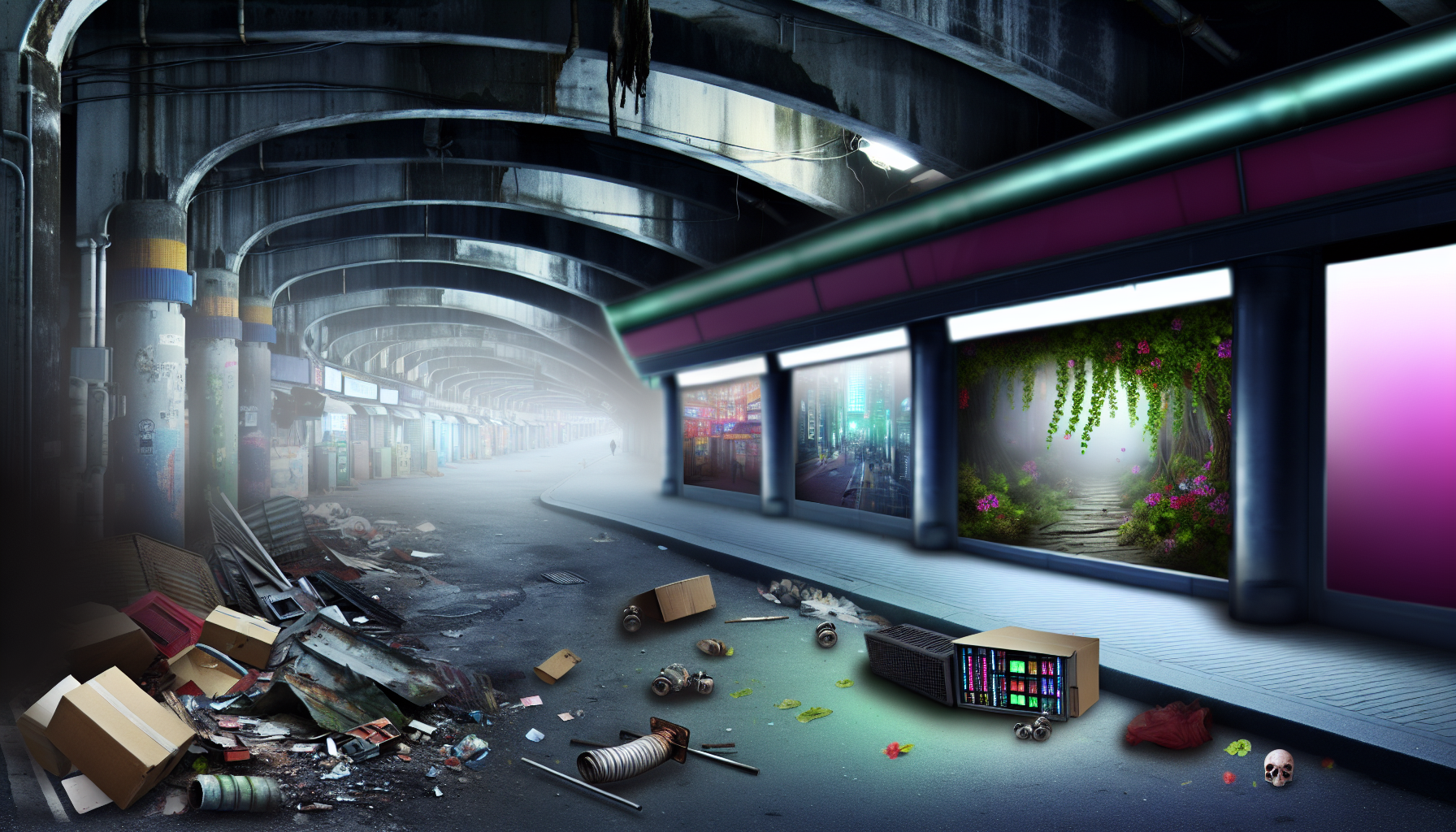It’s a grey dawn, not from the absence of the sun, but due to its fierce battle with the relentless smog that has besieged our city’s vitality. We stride into the veins of a once vibrant cityscape, now a collection of bleached buildings and desolation. Past expeditions have chronicled the obscured skyline, a sobering horizon documented in ‘Under the Smog – A Skyline’s Final Elegy’. Yet, beneath that upper crust lament lies a deeper tale of urban exploration in the aftermath of smog.
Through our smudged goggles, we capture the stoic silence of emptied streets, sites where children’s laughter has been muted by the suffocating haze. Our footsteps echo in this ghost town as we tread cautiously over crumbling sidewalks. The buildings that surround us are festooned with the residue of human withdrawal – a facade of grit and graffiti, offset by the occasional glint of broken glass underfoot.
What used to be storefronts have turned into caverns, secretive and silent. Scanning through the remains, you can almost decode the history of commerce that once boomed here: a cash register still optimistically open, a mannequin donning what was perhaps the last season’s fashion, untouched by consumer hands, now merely a discolored specter.
The metropolis’s underbelly reveals a terrain rife for exploration. Subterranean tunnels, previously pulsing with the lifeblood of urban transport, now rest in tranquil abandon. Light, when it dares penetrate the man-made clouds above, scatters fragmented beams, casting eerie silhouettes within these concrete crypts. Their walls bear witness to the factions of urban explorers and disillusioned rebels, narratives inked in aerosol that channel voices when those above whisper in fear and smog-induced fatigue.
One such cavern is the lair of an ad-hoc archive. Here, amidst the damp and decay, lies a repository of artifacts capturing the last gasps of a society that choked on its own industrial successes. Tablets, phones, computers— relics of a connected world, lie in a power-stricken tableau of what was once instant global reach, rendered mute and impotent by the overbearing skies.
We trace the steps of erstwhile inhabitants, with hidden gardens discovered atop buildings, thriving defiantly against the dire air. It’s here we witness the resilience of the wild: a verdant rebellion sprouting in disregard to mankind’s folly. Nature’s unyielding force, a testament to life’s impassive march, finds a way amidst the ruin. Yet, with each underfoot crunch of dried vine and forsaken flora, we’re reminded of those rooftop gardeners who sought solace from the suffocating streets below— now eerily absent.
Through shutters and cracks, the distant rumbles of unrest and movement whisper secrets of an ecosystem persisting in the shadows. Communities have reshaped and regrouped, covens of human resourcefulness tucked away in resistant bunkers of vitality. Murmurs of trade, whispers of song, embers of life continue, hushed beneath the omnipresent fog.
Exposing this grim yet captivating tableau invites a reflection that’s as haunting as it is enlightening. It’s an unflinching gaze into the perseverance and adaptation of urban culture against eco-crisis, a stark reminder of what has been and what could have been.
We emerge from the desolate fugue state, still resonating with the silent symphony of a city in distress. The smog, an unwavering barrier between two worlds, leaves us with a poignant question: what else orbits beneath the haze, waiting to be uncovered in the aftermath of human silence?
Our exploration today reveals a microcosm of resilience and gives voice to the mute narrative of urban decay. It is but a chapter in the ongoing chronicle of a planet blighted by man’s environmental oversight. The dichotomy of despair and the instinct for survival illustrates the adaptability of civilization under duress, a reminder that amidst the suffocation, there’s life— distorted, refashioned, but resilient.
